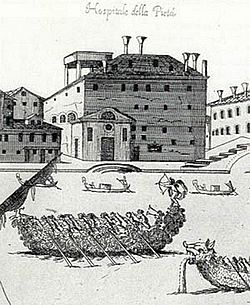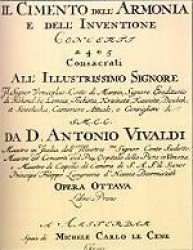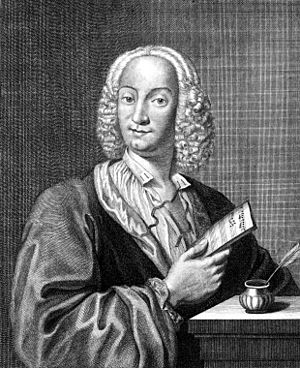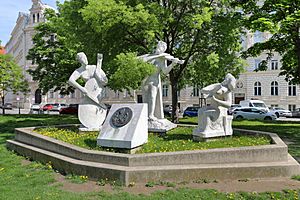Antonio Vivaldi facts for kids
Quick facts for kids
Antonio Vivaldi
|
|
|---|---|
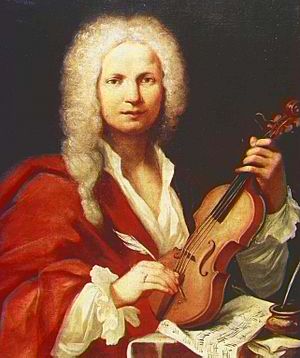
Antonio Vivaldi
|
|
| Born | March 4, 1678 |
| Died | July 28, 1741 (aged 63) Vienna, Austria
|
| Occupation | Composer |
Antonio Vivaldi (born Venice, 4 March 1678; died Vienna, 28 July 1741) was an Italian composer. He was the most important composer in Italy at the end of the Baroque period.
Vivaldi wrote more than 400 concertos for various instruments, especially for the violin. The scores of 21 operas, including his first and last, are still intact. His most popular work is the group of four violin concertos called “The Four Seasons”. Each concerto describes a season: Spring, Summer, Autumn, and Winter. He is believed to be the inventor of the ritornello form. He was very famous for his piccolo compositions, such as Il gardellino.
Contents
Childhood
Antonio Lucio Vivaldi was born on 4 March 1678 in Venice, then the capital of the Venetian Republic. An earthquake shook the city that day. In the trauma of the earthquake, Vivaldi's mother may have dedicated him to the priesthood.
Vivaldi's parents were Giovanni Battista Vivaldi and Camilla Calicchio, as recorded in the register of San Giovanni in Bragora. Vivaldi had five known siblings: Bonaventura Tomaso Vivaldi, Margarita Gabriela Vivaldi, Cecilia Maria Vivaldi, Francesco Gaetano Vivaldi, and Zanetta Anna Vivaldi. His father, Giovanni Battista, who was a barber before becoming a professional violinist, taught Antonio to play the violin and then toured Venice playing the violin with his young son.
Early life
He trained to be a priest, and because of his red hair, he became known as "il prete rosso", which means "the red priest." He did not work as a priest for very long, and in 1703 he began teaching violin to girls at an orphanage in Venice, the Pio Ospedale della Pietà. The name means "Devout Hospital of Mercy." The girls were chosen because they showed exceptional musical abilities. They gave regular concerts, so as part of his duties Vivaldi wrote music for them to play. He lost the job between 1709 and 1711, when he was reappointed. He also took on the extra job of writing sacred music for the girls' choir. He continued teaching until 1716 when he was put in charge of all the music events.
Composing
Vivaldi's music was becoming well known. During his break from teaching between 1709 and 1711 he wrote a large number of works including violin sonatas and concertos. In 1711 a collection of 12 concertos, L'estro armonico op.3, for one, two and four solo violins was published by Etienne Roger in Amsterdam. This made him famous throughout Europe, and musicians coming to Venice would visit Vivaldi for lessons. Further new publications of his music made him even more famous. The first of his many operas, Ottone in villa, was performed in 1713.. His first oratorio, Juditha Triumphans devicta Holofernis barbaric, was performed by the girls from the Pietà in 1716.
Travels
In 1718 Vivaldi left Venice and moved to Mantua, where he became the director of music for the governor, Prince Philip of Hesse-Darmstadt. He composed his famous "Four Seasons" as well as several operas during this time. He went to Rome in about 1721, where he performed on several occasions for the Pope. While he was travelling, he continued to write music for the girls at the Pietà, over the years he sent them about 140 concertos. He went to a number of cities in Europe to have his operas performed including Vienna, Verona, and Prague. He often went back to Venice to rehearse his music with the girls.
Death
Even though his music was popular, Vivaldi did not make a lot of money from his music. As newer musicians, and more modern styles became popular, he found it more difficult to earn a living. He moved to Austria to play for royalty but when the king died, he became poor and had no way to return home. He died, a poor man, in Vienna, on 28 July 1741.
Works
Le quattro stagioni (The Four Seasons) of 1723 is his most famous work. Part of Il cimento dell'armonia e dell'inventione ("The Contest between Harmony and Invention"), it depicts moods and scenes from each of the four seasons. This work has been described as an outstanding instance of pre-19th-century program music.
Vivaldi wrote more than 500 other concertos. About 350 of these are for solo instrument and strings, of which 230 are for violin, the others being for bassoon, cello, oboe, flute, viola d'amore, recorder, lute, or mandolin. About forty concertos are for two instruments and strings, and about thirty are for three or more instruments and strings.
As well as about 46 operas, Vivaldi composed a large body of sacred choral music. Other works include sinfonias, about 90 sonatas and chamber music.
Style and influence
Vivaldi's music was innovative. He brightened the formal and rhythmic structure of the concerto, in which he looked for harmonic contrasts and innovative melodies and themes.
Johann Sebastian Bach was deeply influenced by Vivaldi's concertos and arias (recalled in his St John Passion, St Matthew Passion, and cantatas). Bach transcribed six of Vivaldi's concerti for solo keyboard, three for organ, and one for four harpsichords, strings, and basso continuo (BWV 1065) based upon the concerto for four violins, two violas, cello, and basso continuo (RV 580).
Legacy
In the early 20th century, Fritz Kreisler's Concerto in C, in the Style of Vivaldi (which he passed off as an original Vivaldi work) helped revive Vivaldi's reputation. Kreisler's concerto in C spurred the French scholar Marc Pincherle to begin an academic study of Vivaldi's oeuvre. Many Vivaldi manuscripts were rediscovered, which were acquired by the Turin National University Library as a result of the generous sponsorship of Turinese businessmen Roberto Foa and Filippo Giordano, in memory of their sons. This led to a renewed interest in Vivaldi by, among others, Mario Rinaldi, Alfredo Casella, Ezra Pound, Olga Rudge, Desmond Chute, Arturo Toscanini, Arnold Schering and Louis Kaufman, all of whom were instrumental in the revival of Vivaldi throughout the 20th century.
In 1926, in a monastery in Piedmont, researchers discovered fourteen bound volumes of Vivaldi's work but later on discovered to be fifteen that were previously thought to have been lost during the Napoleonic Wars. Some missing tomes in the numbered set were discovered in the collections of the descendants of the Grand Duke Durazzo, who had acquired the monastery complex in the 18th century. The volumes contained 300 concertos, 19 operas and over 100 vocal-instrumental works.
The resurrection of Vivaldi's unpublished works in the 20th century greatly benefited from the noted efforts of Alfredo Casella, who in 1939 organized the historic Vivaldi Week, in which the rediscovered Gloria (RV 589) and l'Olimpiade were revived. Since World War II, Vivaldi's compositions have enjoyed wide success. Historically informed performances, often on "original instruments", have increased Vivaldi's fame still further.
Recent rediscoveries of works by Vivaldi include two psalm settings of Nisi Dominus (RV 803, in eight movements) and Dixit Dominus (RV 807, in eleven movements). These were identified in 2003 and 2005, respectively, by the Australian scholar Janice Stockigt. The Vivaldi scholar Michael Talbot described RV 807 as "arguably the best nonoperatic work from Vivaldi's pen to come to light since […] the 1920s". Vivaldi's 1730 opera Argippo (RV 697), which had been considered lost, was rediscovered in 2006 by the harpsichordist and conductor Ondřej Macek, whose Hofmusici orchestra performed the work at Prague Castle on 3 May 2008—its first performance since 1730.
Modern depictions of Vivaldi's life include a 2005 radio play, commissioned by the ABC Radio National and written by Sean Riley. Entitled The Angel and the Red Priest, the play was later adapted for the stage and was performed at the Adelaide Festival of the Arts. Films about Vivaldi include Red Venice (1989), an Italian-French co-production under the direction of Étienne Périer, Antonio Vivaldi, a Prince in Venice (2006), an Italian-French co-production under the direction of Jean-Louis Guillermou, and Vivaldi, the Red Priest (2009), loosely based on Antonio's life as both priest and composer.
Images for kids
-
Caricature by P. L. Ghezzi, Rome (1723)
-
Allée Vivaldi, Paris. Named after Antonio Vivaldi.
See also
 In Spanish: Antonio Vivaldi para niños
In Spanish: Antonio Vivaldi para niños


